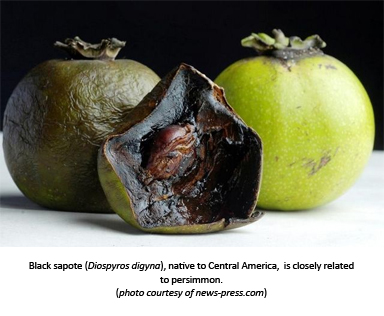Nothing about the black sapote is as you might think. To start with, it’s not black and it’s not a sapote. Nor does it taste anything like its common nickname: chocolate pudding fruit.
 None of which deters fruit evangelist Madeline Bohannon’s zeal for the tropical exotic, which will be “one of the stars” of Saturday’s Bonita Springs Tropical Fruit Club’s annual sale.
None of which deters fruit evangelist Madeline Bohannon’s zeal for the tropical exotic, which will be “one of the stars” of Saturday’s Bonita Springs Tropical Fruit Club’s annual sale.
Actually, this is a good point to pause for a moment to consider what it means to live in a place where a weekend highlight is an open-air bazaar of living, delicacy-producing trees at low, low discount prices no less. (It’s paradise — just in case you needed reminding.)
Back to the black sapote: Bohannon agrees the name is “slightly misleading,” pointing out that it comes from the fruit’s color and consistency when ripe, with creamy chestnut flesh that yields to like custard.
She also notes that it’s better for you than pudding — is high in Vitamin C (four times that of an average orange) as well as calcium and phosphorus. And there’s more. “This is the perfect tree for snowbirds, as the fruit matures mostly in January and February, she says. Black sapotes aren’t fussy, and they grow fast.
“You can plant the seed from the fruit you eat today and then about four years from now you’ll get a fully grown tree big enough to have fruit. Plus, the tree itself is a very attractive addition to any yard, with its deep green, glossy leaves.”
Indeed. A member of the persimmon family that ranges in the wild from Mexico to South America, black sapotes are handsome trees with glossy evergreen foliage and strikingly dark trunks and limbs.
After they flower, fruit begin forming, eventually reaching baseball size. At first, the fruit will be hard and dark green. After about 10 days, the skin will begin to darken to a rich olive and the fruit will begin to yield to the touch, avocado-style. At that point, they can be kept refrigerated another few days. When it comes to harvesting, patience is a necessary virtue. Unripe black sapotes are mouth-puckeringly astringent and tart to the point of near-pain. But when they’re ripe and ready, they’re wonderful, Bohannon says.
“The most unique thing about that fruit is you can taste the fragrance more than you can smell it,” she says. “Now that sounds like a weird thing to say, but it’s slightly perfume-y and different from any other fruit in that respect.”
In addition to simply spooning them from the skins, she uses them in smoothies, puddings and “chocolate” mousse — one of Bohannon’s very favorite recipes. As easy as it is healthy, she makes it by combining freshly pureed black sapote with whipped cream, chocolate syrup and Kahlua.
Her description of the result? Simple: “Yum!”
Source: news-press.com
